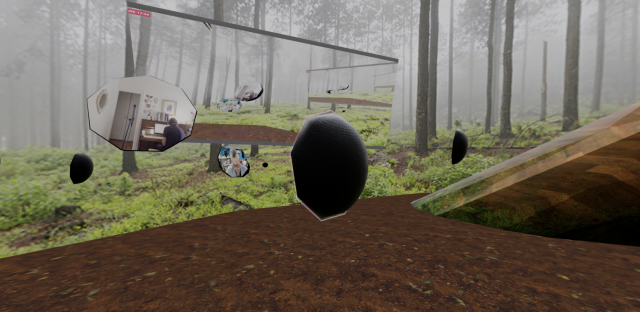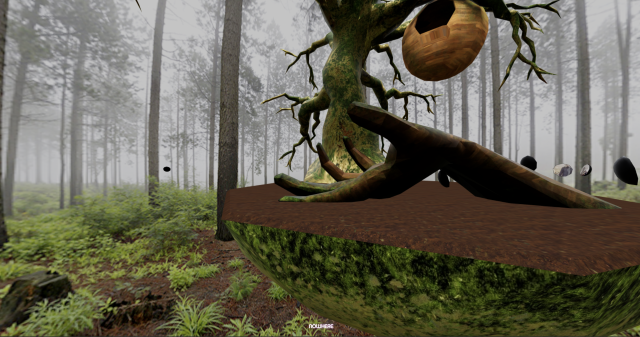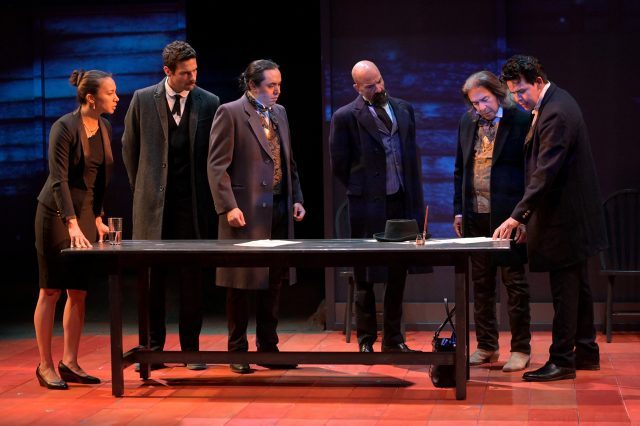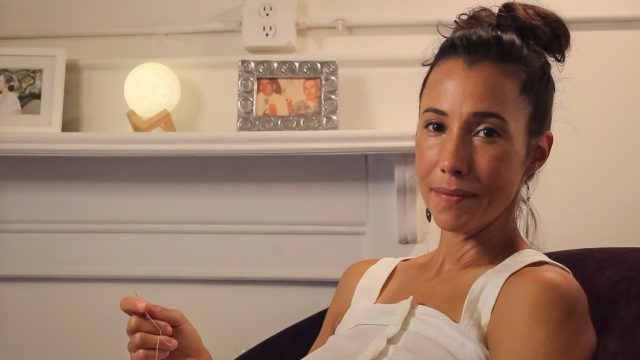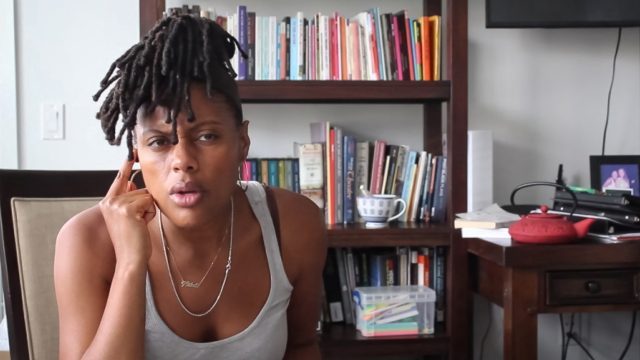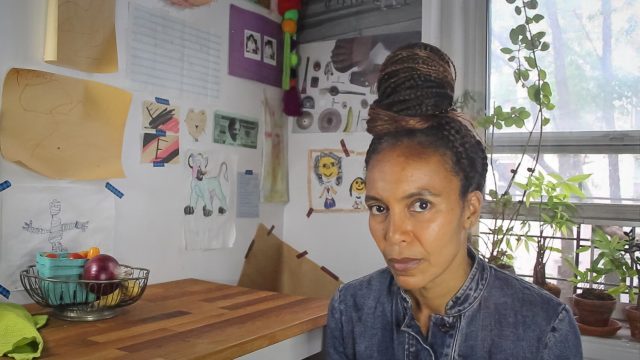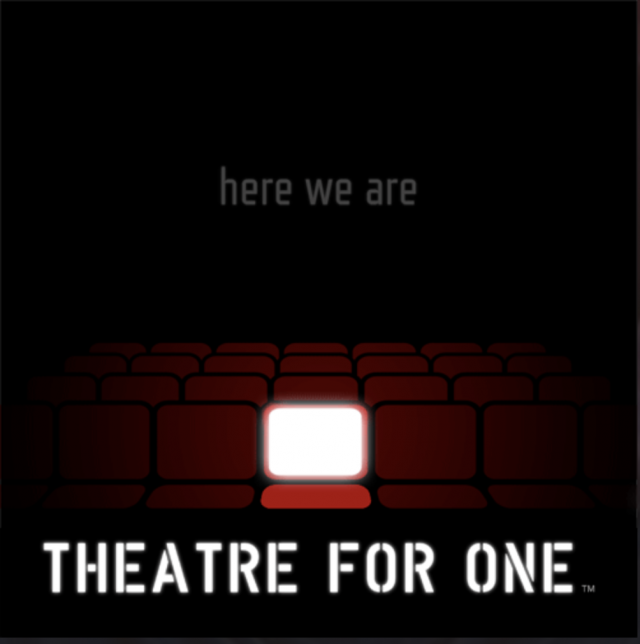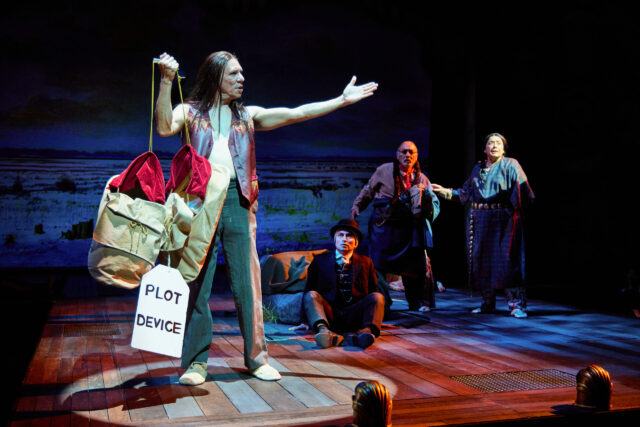
Justin Gauthier serves as the narrator while playing numerous other roles in Between Two Knees (photo by Jeremy Daniel)
BETWEEN TWO KNEES
Perelman Performing Arts Center (PAC NYC)
251 Fulton St.
Tuesday – Saturday through February 24, $29-$79
pacnyc.org
www.1491s.com
White people receive quite a spanking in the New York premiere of the 1491s’ irreverent, hilarious, and scattershot theatrical history lesson, Between Two Knees.
The 1491s are a Native American sketch comedy troupe from Minnesota and Oklahoma whose members have been involved in such television series as Rutherford Falls and Reservation Dogs. In Between Two Knees, they lead the audience on a wild ride from the Wounded Knee Massacre of December 29, 1890, to the American Indian Movement’s (AIM) occupation of Wounded Knee beginning on February 27, 1973. The narrative traces several generations of an Indian family as they try to find their place in a country that only knows how to take from them, treating them with disrespect and violence every step of the way.
As the crowd enters the theater at the Perelman Performing Arts Center (PAC NYC), themed music plays, including such songs as Cher’s “Half-Breed.” Regina García’s set features a thrust stage and a backdrop with cardboard cutouts of former Cleveland Indians logo and mascot Chief Wahoo (the team was recently renamed the Guardians), the Chicago Blackhawks’ logo of an Indian head (inspired by the real-life Black Hawk of Illinois’s Sac and Fox Nation), and the Land o’ Lakes woman with a target on her stomach. A red curtain opens and closes as scenes change like vaudeville acts. Props range from a covered wagon, US army and FBI rifles and guns, and a tiny western house to a small kitchen, a hippie pedestal, and Custer’s Last Stand Bar. Lux Haac’s costumes are often tongue-in-cheek versions of traditional Native clothing.
The fun kicks off with the opening announcement telling everyone to turn off their phones, followed by a riff on the standard land acknowledgment. Introducing the play, the emcee, Larry (Justin Gauthier), provides a content warning: “Good evening, fellow Indians, and other. Take a deep breath. Ahhh, you smell that? It smells like inherited wealth, privilege, and a tad bit of guilt in this room. White people! It’s good to see you here, aho! Bet you haven’t heard that in a while. Thank you for coming to this Native American Indian show. I just want you to know, you’re about to see some heavy stuff. I mean, let’s be honest here, we’re talking about INDIANS. And Indians have been through some pretty dark shit. I mean, DARK shit. All caused by you people. Yup. You all tried your best to wipe us out and clean us off the map. I mean, can you imagine how hard it was to cast this play? We had to use a Chinese guy to play one of the Indians.”
The actor steps forward and explains, “Actually, Korean. But whatever,” a revealing joke about personal identity.

Members of the 1491s pose as a museum diorama in New York premiere at PAC NYC (photo by Jeremy Daniel)
Larry continues, “We’re gonna make this fun. We’re gonna talk about war and genocide and PTSD and molestation. So it’s ok to laugh. You are going to feel some guilt watching this. But don’t worry. That’s just what it feels like to be confronted with the source of your social power. That’s why we are passing a donation bin around the audience tonight. For just the price of a cup of coffee, you . . . can help a grown Indian child in need. Yup, yup. Just pass the can along. Don’t be cheap now. I promise, when you leave, you will still own everything. And Indians, if you’re in the audience and you got those free tickets, I better hear some quarters dropping into that can. C’mon, don’t be a stereotype. Everybody already thinks we get free college.”
The first skit involves spinning the Wheel of Indian Massacre, which first stops on the Pound Ridge Massacre, then the Raritan Massacre, and finally Wounded Knee, which gets the main plot underway. But Larry promises, “THIS is not a story about death. This is a story about life.”
Over the course of a far-too-long two hours and forty-five minutes (including intermission), Pale Face and Witko try to protect Ina from a white soldier; an Indian baby is sent to a Christian reeducation boarding school and renamed Isaiah, where he meets the feisty Irma, who refuses to give in to the evil priest and strange nuns; Indians are sent off to fight in WWII and Vietnam; and AIM returns to Wounded Knee, proclaiming, “Time to unite and defend the people!” Through it all, a pair of tiny baby moccasins ties everything together, passing along trauma and hope to the next generations.
Eight ensemble members — Gauthier, Rachel Crowl, Derek Garza, Shyla Lefner, Wotko Long, James Ryen, Shaun Taylor-Corbett, Sheila Tousey — portray more than seventy characters, from Jesus, Satan, Ghost of Lakota Woman, and Singing Deer to a sexy temptress, a man with an eagle in his pants, Vanna White, and the Vietnam War as Interpretive Dance. Along the way we learn about and are reminded of various anti-Indian laws, manifest destiny, spirit animals, cultural appropriation, Native American rituals, colonization, and “the atrocities of the United SNAKES of Amerika.”
Much of the show is clever and heartfelt, its sociopolitical points emerging sharply from all the joking around, performed by likable actors who make connections with the audience, which, at the matinee I attended, was filled with more Native Americans than I had ever seen in a theater before. The Indians and the non-Indians didn’t always respond the same way to certain lines and bits; the 1491s are expert at making white people laugh at themselves amid the guilt and privilege but are careful not to cause too much discomfort.
However, some scenes are others are over-the-top farce that lose their power with random silliness. Obie-winning director Eric Ting (The Far Country, The World of Extreme Happiness) lets too many scenes run on, with a bevy of stray parts. The DIY feel extends to Elizabeth Harper’s playful lighting, Ty Defoe’s humorous choreography, and Shawn Duan’s projections, but the self-deprecating emphasis on the company’s supposed lack of technical expertise peters out. The five musical numbers, including “Touchy Touchy Tickle Touchy,” “The Song of Eddie Wolf,” and “Aimstas Paradise,” are as hit-or-miss as the comedy sketches.
The lavish PAC NYC is the right place for Between Two Knees. At intermission, I walked outside to the 9/11 Memorial, the moving tribute to the nearly three thousand men, women, and children killed in the terrorist attacks of September 11, 2001. The World Trade Center — among numerous other NYC buildings — was built by hundreds of Mohawk Skywalkers, and Native Americans arrived in force to the site after 9/11 to help in the dangerous cleanup. So Native Americans know all about 9/11, but non-Indians know little or nothing about December 29, a critical date in the history of this nation.
After intermission, Larry says, “Good evening, friends and relatives. Welcome back to Between Two Knees, an intergenerational tale of familial love, loss, and triumph. Thanks for returning. I know it can be a real slog to sit through these diversity shows. But if you’re still here with us, you’ve clearly been gifted with elevated artistic tastes. Everyone else ran home to rewatch their favorite Yellowstone spin-offs. Please note that those who left in a huff during intermission have been refunded the fair market value of their ticket, in beads. Aho, good trade.”
The show continues at PAC NYC through February 24. Tickets are $29 to $79; beads are not accepted.
[Mark Rifkin is a Brooklyn-born, Manhattan-based writer and editor; you can follow him on Substack here.]

